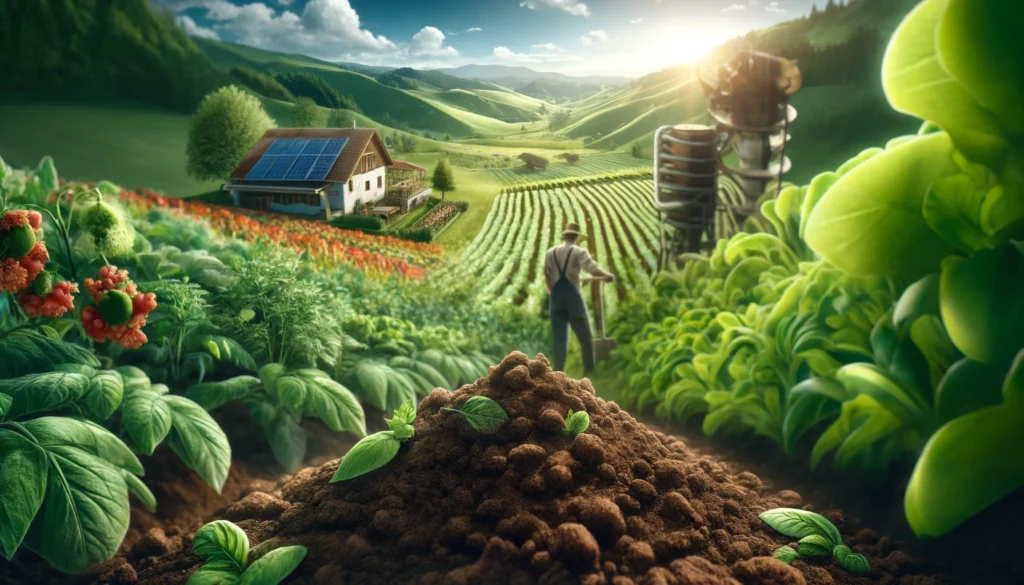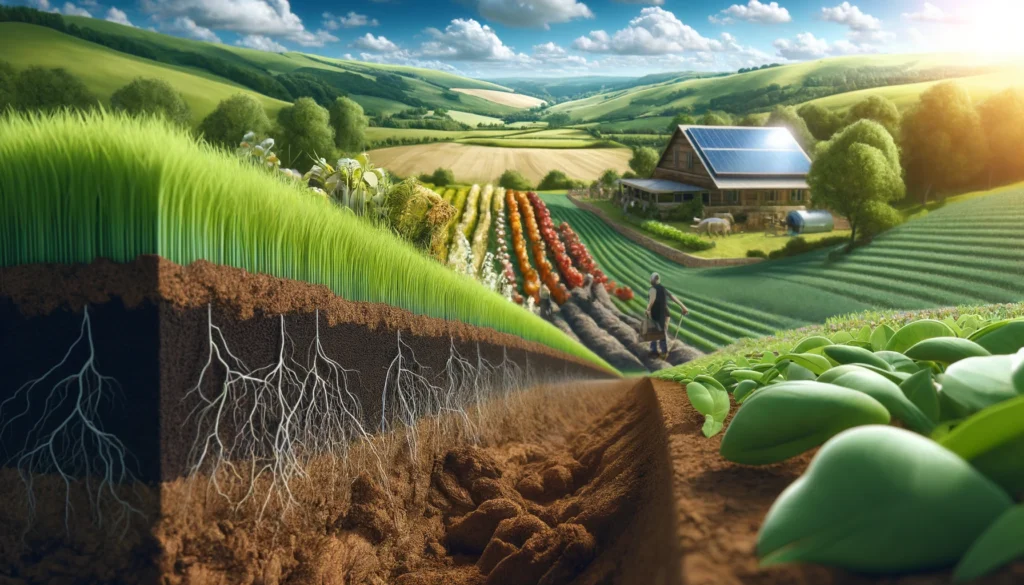Comprehensive Guide to Sustainable Farming
Sustainable farming is an approach to agriculture that focuses on producing food in a way that preserves the environment, supports animal welfare, and enhances the quality of life for farmers and communities. This comprehensive guide will explore various aspects of sustainable farming, including its principles, practices, benefits, and challenges. It will provide detailed insights, practical tips, and sustainable practices that farmers can adopt to enhance their farming operations.
Understanding Sustainable Farming
What is Sustainable Farming?
Sustainable farming refers to agricultural practices that meet current food needs without compromising the ability of future generations to meet their own needs. It integrates three main goals: environmental health, economic profitability, and social and economic equity.
Principles of Sustainable Farming
- Environmental Stewardship: Protecting and enhancing the environment by minimizing the use of harmful chemicals, conserving water, and promoting biodiversity.
- Economic Viability: Ensuring that farming practices are economically sustainable for farmers and rural communities.
- Social Responsibility: Supporting fair labor practices, community well-being, and animal welfare.
Importance of Sustainable Farming
- Resource Conservation: Sustainable farming practices help conserve natural resources like soil, water, and biodiversity.
- Climate Change Mitigation: Reducing greenhouse gas emissions and enhancing carbon sequestration through sustainable practices.
- Food Security: Ensuring a stable food supply for current and future generations.
- Health and Safety: Producing food without harmful chemicals, benefiting both consumers and farm workers.
Key Practices in Sustainable Farming
Soil Health Management
- Crop Rotation: Rotating crops to break pest and disease cycles, improve soil structure, and enhance soil fertility.
- Cover Cropping: Planting cover crops to protect soil from erosion, improve soil organic matter, and suppress weeds.
- Reduced Tillage: Minimizing soil disturbance to maintain soil structure, reduce erosion, and enhance microbial activity.
- Organic Amendments: Adding organic matter such as compost, manure, and green manures to improve soil fertility and structure.
Water Conservation
- Efficient Irrigation: Using efficient irrigation systems like drip or micro-sprinklers to reduce water use.
- Rainwater Harvesting: Collecting and storing rainwater for irrigation and other farm uses.
- Mulching: Applying mulch to retain soil moisture, reduce evaporation, and suppress weeds.
- Soil Moisture Monitoring: Using soil moisture sensors to optimize irrigation schedules and avoid overwatering.
Integrated Pest Management (IPM)
- Biological Controls: Using natural predators and beneficial insects to control pest populations.
- Cultural Practices: Implementing crop rotation, intercropping, and resistant varieties to manage pests and diseases.
- Mechanical Controls: Using physical methods like traps, barriers, and hand-picking to reduce pest numbers.
- Chemical Controls: Applying pesticides as a last resort, using targeted applications to minimize environmental impact.
Biodiversity Enhancement
- Agroforestry: Integrating trees and shrubs into agricultural landscapes to enhance biodiversity, improve soil health, and provide additional income sources.
- Hedgerows and Buffer Strips: Planting hedgerows and buffer strips to provide habitat for wildlife, reduce erosion, and capture runoff.
- Polyculture: Growing multiple crops in the same space to promote biodiversity and resilience to pests and diseases.
- Wildlife Conservation: Creating and maintaining habitats for beneficial wildlife, including birds, bats, and pollinators.
Energy Efficiency
- Renewable Energy: Using renewable energy sources like solar, wind, and bioenergy to power farm operations.
- Energy-Efficient Equipment: Investing in energy-efficient machinery and appliances to reduce energy consumption and costs.
- Conservation Practices: Implementing practices like no-till farming and cover cropping to reduce fuel use and greenhouse gas emissions.
Animal Welfare
- Humane Treatment: Ensuring that animals are treated humanely, with access to clean water, adequate food, and proper shelter.
- Pasture-Based Systems: Raising animals on pasture to allow natural behaviors and improve animal health and well-being.
- Health Management: Using preventative healthcare measures, such as vaccinations and parasite control, to maintain animal health.
- Ethical Slaughter: Following ethical guidelines for the humane slaughter of animals.
Benefits of Sustainable Farming
Environmental Benefits
- Soil Health: Improved soil structure, fertility, and organic matter content through practices like crop rotation, cover cropping, and reduced tillage.
- Water Conservation: Efficient water use and reduced runoff through efficient irrigation, rainwater harvesting, and mulching.
- Biodiversity: Enhanced biodiversity through agroforestry, polyculture, and wildlife conservation practices.
- Climate Resilience: Increased resilience to climate change through diversified cropping systems and improved soil health.
Economic Benefits
- Cost Savings: Reduced input costs through efficient resource use, such as water, energy, and fertilizers.
- Market Opportunities: Access to premium markets for organic and sustainably produced products.
- Farm Profitability: Improved farm profitability through diversified income streams and value-added products.
- Long-Term Viability: Sustainable practices that ensure the long-term viability of farming operations.
Social Benefits
- Community Well-Being: Supporting rural communities through fair labor practices and local economic development.
- Food Security: Ensuring a stable and secure food supply for current and future generations.
- Consumer Health: Producing food without harmful chemicals, benefiting consumers’ health and well-being.
- Animal Welfare: Ensuring humane treatment of farm animals and promoting ethical farming practices.
Challenges of Sustainable Farming
Financial Challenges
- Initial Investment: High initial costs for transitioning to sustainable practices, such as purchasing new equipment and adopting new technologies.
- Access to Credit: Difficulty in accessing credit and financial support for sustainable farming initiatives.
- Market Access: Limited access to markets for sustainably produced products, particularly for small-scale farmers.
Technical Challenges
- Knowledge and Skills: Need for specialized knowledge and skills to implement sustainable farming practices effectively.
- Infrastructure: Lack of infrastructure and resources to support sustainable farming, such as processing facilities and storage.
- Climate Variability: Challenges posed by climate variability and extreme weather events on sustainable farming practices.
Policy and Regulatory Challenges
- Regulatory Barriers: Regulatory barriers that restrict the adoption of sustainable practices, such as restrictive land-use policies.
- Policy Support: Lack of policy support and incentives for sustainable farming initiatives.
- Certification and Standards: Complexity and cost of obtaining certification for organic and sustainably produced products.

Sustainable Farming Practices in the UK
Organic Farming
- Organic Certification: Following organic certification standards set by organizations like the Soil Association to produce organic food.
- Natural Inputs: Using natural inputs, such as organic fertilizers and pesticides, to maintain soil fertility and control pests.
- Animal Welfare: Ensuring high standards of animal welfare through pasture-based systems and humane treatment.
- Crop Diversity: Promoting crop diversity through crop rotation, polyculture, and intercropping.
Regenerative Agriculture
- Soil Regeneration: Focus on regenerating soil health through practices like cover cropping, reduced tillage, and composting.
- Biodiversity Enhancement: Enhancing biodiversity through agroforestry, polyculture, and wildlife conservation.
- Carbon Sequestration: Increasing carbon sequestration through practices like no-till farming and planting cover crops.
- Water Management: Implementing water conservation techniques like efficient irrigation and rainwater harvesting.
Agroforestry
- Silvopasture: Integrating trees and shrubs into pasture systems to provide shade, shelter, and additional income sources.
- Forest Farming: Growing crops under the canopy of a forest to promote biodiversity and sustainable land use.
- Windbreaks: Planting trees and shrubs as windbreaks to reduce soil erosion and protect crops.
- Riparian Buffers: Establishing riparian buffers along waterways to protect water quality and provide wildlife habitat.
Permaculture
- Design Principles: Applying permaculture design principles to create self-sustaining and resilient agricultural systems.
- Diverse Plantings: Planting a diverse mix of crops, trees, and shrubs to promote biodiversity and resilience.
- Water Harvesting: Implementing water harvesting techniques like swales and ponds to capture and store rainwater.
- Soil Building: Building healthy soil through composting, mulching, and cover cropping.
Conservation Agriculture
- Minimal Soil Disturbance: Practicing minimal soil disturbance through no-till or reduced tillage farming.
- Permanent Soil Cover: Maintaining permanent soil cover through cover cropping and mulching.
- Crop Rotation: Implementing diverse crop rotations to improve soil health and reduce pest and disease pressure.
- Integrated Pest Management (IPM): Using IPM techniques to manage pests and diseases sustainably.
Practical Tips for Sustainable Farming
Soil Health Management
- Regular Soil Testing: Conduct regular soil tests to monitor soil fertility and pH levels, and adjust management practices accordingly.
- Composting: Apply compost to improve soil fertility and structure, and increase organic matter content.
- Cover Cropping: Plant cover crops to protect soil from erosion, improve soil organic matter, and suppress weeds.
- Reduced Tillage: Minimize soil disturbance to maintain soil structure, reduce erosion, and enhance microbial activity.
Water Conservation
- Efficient Irrigation: Use efficient irrigation systems like drip or micro-sprinklers to reduce water use.
- Rainwater Harvesting: Collect and store rainwater for irrigation and other farm uses.
- Mulching: Apply mulch to retain soil moisture, reduce evaporation, and suppress weeds.
- Soil Moisture Monitoring: Use soil moisture sensors to optimize irrigation schedules and avoid overwatering.
Integrated Pest Management (IPM)
- Biological Controls: Use natural predators and beneficial insects to control pest populations.
- Cultural Practices: Implement crop rotation, intercropping, and resistant varieties to manage pests and diseases.
- Mechanical Controls: Use physical methods like traps, barriers, and hand-picking to reduce pest numbers.
- Chemical Controls: Apply pesticides as a last resort, using targeted applications to minimize environmental impact.
Biodiversity Enhancement
- Agroforestry: Integrate trees and shrubs into agricultural landscapes to enhance biodiversity, improve soil health, and provide additional income sources.
- Hedgerows and Buffer Strips: Plant hedgerows and buffer strips to provide habitat for wildlife, reduce erosion, and capture runoff.
- Polyculture: Grow multiple crops in the same space to promote biodiversity and resilience to pests and diseases.
- Wildlife Conservation: Create and maintain habitats for beneficial wildlife, including birds, bats, and pollinators.
Energy Efficiency
- Renewable Energy: Use renewable energy sources like solar, wind, and bioenergy to power farm operations.
- Energy-Efficient Equipment: Invest in energy-efficient machinery and appliances to reduce energy consumption and costs.
- Conservation Practices: Implement practices like no-till farming and cover cropping to reduce fuel use and greenhouse gas emissions.
Animal Welfare
- Humane Treatment: Ensure that animals are treated humanely, with access to clean water, adequate food, and proper shelter.
- Pasture-Based Systems: Raise animals on pasture to allow natural behaviors and improve animal health and well-being.
- Health Management: Use preventative healthcare measures, such as vaccinations and parasite control, to maintain animal health.
- Ethical Slaughter: Follow ethical guidelines for the humane slaughter of animals.
Case Studies in Sustainable Farming
Case Study 1: Organic Dairy Farming in Somerset
Location: Somerset, England
Practices:
- Organic Certification: Following organic certification standards set by the Soil Association to produce organic milk.
- Pasture-Based System: Raising dairy cows on pasture to allow natural behaviors and improve animal health and well-being.
- Cover Cropping: Planting cover crops to protect soil from erosion, improve soil organic matter, and suppress weeds.
- Renewable Energy: Using solar panels to power the dairy operation and reduce reliance on fossil fuels.
Outcomes: The farm has achieved high milk quality, reduced input costs, and increased profitability through sustainable practices.
Case Study 2: Regenerative Agriculture in Wales
Location: Pembrokeshire, Wales
Practices:
- Soil Regeneration: Focus on regenerating soil health through practices like cover cropping, reduced tillage, and composting.
- Biodiversity Enhancement: Enhancing biodiversity through agroforestry, polyculture, and wildlife conservation.
- Carbon Sequestration: Increasing carbon sequestration through practices like no-till farming and planting cover crops.
- Water Management: Implementing water conservation techniques like efficient irrigation and rainwater harvesting.
Outcomes: The farm has significantly improved soil health, increased biodiversity, and enhanced resilience to climate change.
Case Study 3: Permaculture Farm in Scotland
Location: Aberdeenshire, Scotland
Practices:
- Permaculture Design: Applying permaculture design principles to create a self-sustaining and resilient agricultural system.
- Diverse Plantings: Planting a diverse mix of crops, trees, and shrubs to promote biodiversity and resilience.
- Water Harvesting: Implementing water harvesting techniques like swales and ponds to capture and store rainwater.
- Soil Building: Building healthy soil through composting, mulching, and cover cropping.
Outcomes: The farm has achieved high productivity, enhanced biodiversity, and improved resilience to climate variability.
Case Study 4: Conservation Agriculture in Northern Ireland
Location: County Down, Northern Ireland
Practices:
- Minimal Soil Disturbance: Practicing minimal soil disturbance through no-till or reduced tillage farming.
- Permanent Soil Cover: Maintaining permanent soil cover through cover cropping and mulching.
- Crop Rotation: Implementing diverse crop rotations to improve soil health and reduce pest and disease pressure.
- Integrated Pest Management (IPM): Using IPM techniques to manage pests and diseases sustainably.
Outcomes: The farm has improved soil health, reduced erosion, and increased resilience to pests and diseases.
Conclusion
Sustainable farming is essential for ensuring the long-term viability of agriculture and preserving the environment for future generations. By adopting sustainable practices, farmers can improve soil health, conserve water, enhance biodiversity, and ensure economic viability. This comprehensive guide provides the knowledge, practical tips, and strategies that farmers need to implement sustainable farming practices successfully.
By focusing on soil health management, water conservation, integrated pest management, biodiversity enhancement, energy efficiency, and animal welfare, farmers can create resilient and productive farming systems. With the right approach, sustainable farming can lead to a prosperous and sustainable future for farmers and their communities.

